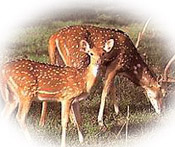Situated in the district of Daltonganj, Palamau Sanctuary is spread over
an area of 979sq.km. The core area of 232 sq. kms of the sanctuary was
declared as Betla National park in September1989. The park occupies the
western parts of the Chotanagpur plateau and was constituted in the year
1960 as an extension of the Hazaribagh National park. Palamau has the
distinction of being the forest where the world's first tiger census was
enumerated in 1932. The park became one of the earliest 9 tiger reserves
in India under 'Project Tiger' in 1974.
The forests of the park have a vast range of vegetation
consisting of tropical wet evergreen forests in the lower reaches, mixed
(moist & dry) deciduous forests in the middle and temperate alpine
forests in the upper reaches including Sal and bamboo as the major components
along with a number of medicinal plants. The river Koel and its tributaries
run through the northern portion of the park. There are grasslands in
the river flowing area. It has waterfalls and hot springs too. Once the
seat of Chero kings, there are two  historical
forts, one of them belonging to the 16th century deep inside the forest.
The main sentinel of the old fort is visible high up on the hill with
defences in three directions and three main gates. historical
forts, one of them belonging to the 16th century deep inside the forest.
The main sentinel of the old fort is visible high up on the hill with
defences in three directions and three main gates.
The diversity of eco-system promotes a wide variety of
fauna consisting of elephant, panther, leopard, wild boar, tiger, gaur,
sloth bear, sambar, chital, nuntjac, nilgai, langur, mouse deer, monkeys,
small Indian civet, mongoose, jackals, porcupine, ant eating pangolin
etc. Elephants in large numbers are seen mostly during the monsoons up
to the time when water sources begin to dry up in March. Jackal and hyena
are common scavengers. Bird-life is rich featuring the hornbill, peafowl,
red jungle fowl, black partridge, white necked stork, black ibis, swamp
grey, quail, the pied born bill, wagtails, the harial, doves, drongo,
the crested serpent-eagle, forest owls, the papiha and other birds usually
found in dry deciduous forests. The famous Kamaldah lake attracts several
varieties of water birds including the common whistling and cotton teal,
the comb duck, snipe and geese. The rhesus monkey and the common languor
provide attraction to children visiting the park.
Described as one of the finest parks in the north-east
for observing a variety of wild life from close range, there are elephant
rides and jeeps available with guides and spotlight for venturing inside
the park. Watch towers and ground hides have been constructed to view
the wild life. Only group travel is recommended. Timings are from 0500
to 1900 hours.
|

